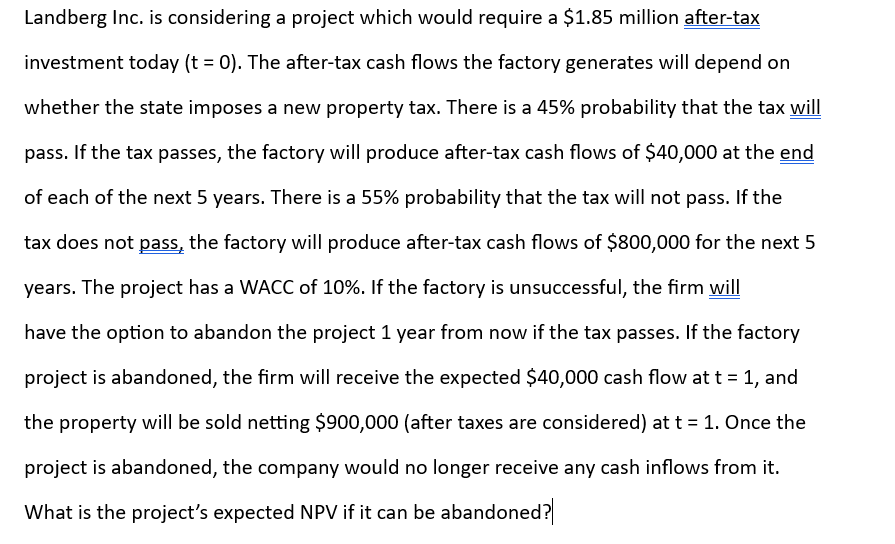Landberg Inc. is considering a project which would require a $1.85 million after-tax investment today (t = 0). The after-tax cash flows the factory generates will depend on whether the state imposes a new property tax. There is a 45% probability that the tax will pass. If the tax passes, the factory will produce after-tax cash flows of $40,000 at the end of each of the next 5 years. There is a 55% probability that the tax will not pass. If the tax does not pass, the factory will produce after-tax cash flows of $800,000 for the next 5 years. The project has a WACC of 10%. If the factory is unsuccessful, the firm will have the option to abandon the project 1 year from now if the tax passes. If the factory project is abandoned, the firm will receive the expected $40,000 cash flow at t = 1, and the property will be sold netting $900,000 (after taxes are considered) at t = 1. Once the project is abandoned, the company would no longer receive any cash inflows from it. What is the project's expected NPV if it can be abandoned?
Landberg Inc. is considering a project which would require a $1.85 million after-tax investment today (t = 0). The after-tax cash flows the factory generates will depend on whether the state imposes a new property tax. There is a 45% probability that the tax will pass. If the tax passes, the factory will produce after-tax cash flows of $40,000 at the end of each of the next 5 years. There is a 55% probability that the tax will not pass. If the tax does not pass, the factory will produce after-tax cash flows of $800,000 for the next 5 years. The project has a WACC of 10%. If the factory is unsuccessful, the firm will have the option to abandon the project 1 year from now if the tax passes. If the factory project is abandoned, the firm will receive the expected $40,000 cash flow at t = 1, and the property will be sold netting $900,000 (after taxes are considered) at t = 1. Once the project is abandoned, the company would no longer receive any cash inflows from it. What is the project's expected NPV if it can be abandoned?
Managerial Economics: A Problem Solving Approach
5th Edition
ISBN:9781337106665
Author:Luke M. Froeb, Brian T. McCann, Michael R. Ward, Mike Shor
Publisher:Luke M. Froeb, Brian T. McCann, Michael R. Ward, Mike Shor
Chapter17: Making Decisions With Uncertainty
Section: Chapter Questions
Problem 17.1IP
Related questions
Question

Transcribed Image Text:Landberg Inc. is considering a project which would require a $1.85 million after-tax
investment today (t = 0). The after-tax cash flows the factory generates will depend on
whether the state imposes a new property tax. There is a 45% probability that the tax will
pass. If the tax passes, the factory will produce after-tax cash flows of $40,000 at the end
of each of the next 5 years. There is a 55% probability that the tax will not pass. If the
tax does not pass, the factory will produce after-tax cash flows of $800,000 for the next 5
years. The project has a WACC of 10%. If the factory is unsuccessful, the firm will
have the option to abandon the project 1 year from now if the tax passes. If the factory
project is abandoned, the firm will receive the expected $40,000 cash flow at t = 1, and
the property will be sold netting $900,000 (after taxes are considered) at t = 1. Once the
project is abandoned, the company would no longer receive any cash inflows from it.
What is the project's expected NPV if it can be abandoned?
Expert Solution
This question has been solved!
Explore an expertly crafted, step-by-step solution for a thorough understanding of key concepts.
This is a popular solution!
Trending now
This is a popular solution!
Step by step
Solved in 3 steps with 2 images

Knowledge Booster
Learn more about
Need a deep-dive on the concept behind this application? Look no further. Learn more about this topic, economics and related others by exploring similar questions and additional content below.Recommended textbooks for you

Managerial Economics: A Problem Solving Approach
Economics
ISBN:
9781337106665
Author:
Luke M. Froeb, Brian T. McCann, Michael R. Ward, Mike Shor
Publisher:
Cengage Learning


Managerial Economics: A Problem Solving Approach
Economics
ISBN:
9781337106665
Author:
Luke M. Froeb, Brian T. McCann, Michael R. Ward, Mike Shor
Publisher:
Cengage Learning
